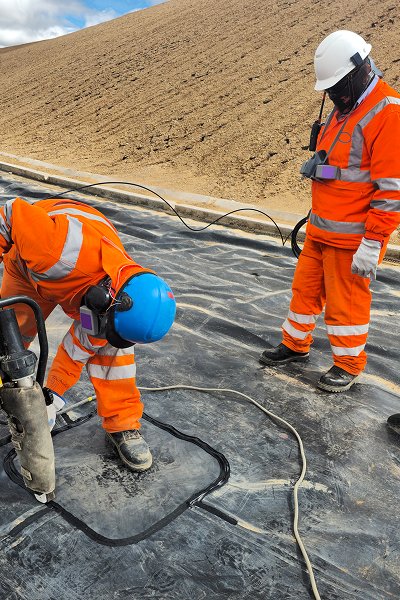What is Geotube ?
Geotubes are large, tubular dewatering containers made of high-strength woven geotextile. High-moisture slurry or tailings is pumped into the tube, where gravity and filtration allow water to drain while retaining solids.
Geotubes are woven from polypropylene (PP) or polyester (PET) materials, with a fine pore structure on the surface that effectively filters moisture while preventing the loss of fine particles. After filling, the solids inside the tube gradually dry and solidify, forming a reusable stockpile structure.
Working principle of geotube
Filling Stage
Materials containing solid particles (such as river mud, tailings slurry, sludge, etc.) are transported into the Geotube using a mud pump or dredging pipeline. During filling, the geotube gradually inflates and takes shape.
Dewatering Stage
In a static state, the geotube material allows water to drain through the fabric pores while retaining solid particles. **Polymer flocculants (PAM)** are typically added to accelerate settling and water separation.
Consolidation Stage
Over time, the internal solid volume decreases and the density increases, causing the geotube to gradually settle and consolidate, forming a stable structure. The dried solids at this stage can be used as dam filling material, temporary storage areas, or permanent shoreline structures.
Material and structural design
Woven Geotextile
Woven from high-strength polypropylene (PP) or polyester (PET) fibers, it boasts extremely high tensile strength and weather resistance. Its fabric pore size (AOS) is typically controlled between 0.2 and 0.6 mm to achieve optimal filtration.
Seam Construction
Geotube seams are usually constructed using double-stitched or triple-stitched seams to ensure no cracking or leakage during high-pressure filling.
Tube Dimension
Common perimeter: 6–30 meters
Length range: 10–100 meters
Customizable to project requirements
Design typically involves calculating the required volume and number of tubes based on site space, filling volume, and final stack height.
Applications
Coastal Protection and Dike Construction: Geotubes can be used as flexible dikes or breakwater structures to effectively prevent coastal erosion and tidal washout.
Dredging Dewatering: In port, river, or lake dredging, Geotubes serve as temporary dewatering containers, quickly separating mud and water for easy transport and storage.
Tailings and Industrial Waste Slurry Treatment: In the treatment of mine tailings, chemical sludge, and papermaking waste slurry, Geotubes enable large-scale dewatering and safe storage.
Municipal and Environmental Engineering: Suitable for sludge dewatering in wastewater treatment plants, polluted river remediation, and environmental solid waste reduction projects.
Emergency Flood Control and Disaster Control: In flood emergencies, Geotubes can be filled with mortar to form temporary waterproof walls for rapid deployment.


Design and Installation Considerations
Site Preparation: Level the foundation and lay the geomembrane.
Layout Planning: Determine the arrangement of pipes and bags based on the terrain and drainage direction.
Connection Sealing: Ensure no leakage at the pipe-bag joints.
Filling Control: Pump in stages to avoid overpressure or bulging.
Dehydration Monitoring: Observe the flow rate and cleanliness of the drainage outlet.
Curing Treatment: Seal the outlet after allowing it to stand until the moisture content meets the requirements.
Geotube technology is becoming a key innovation in the global water, environmental, and infrastructure sectors due to its superior dewatering efficiency, excellent structural performance, and outstanding environmental characteristics.
From coastal protection to tailings management, from port dredging to sludge dewatering, it is replacing traditional, energy-intensive solid-liquid separation methods and becoming an important symbol of green engineering.


